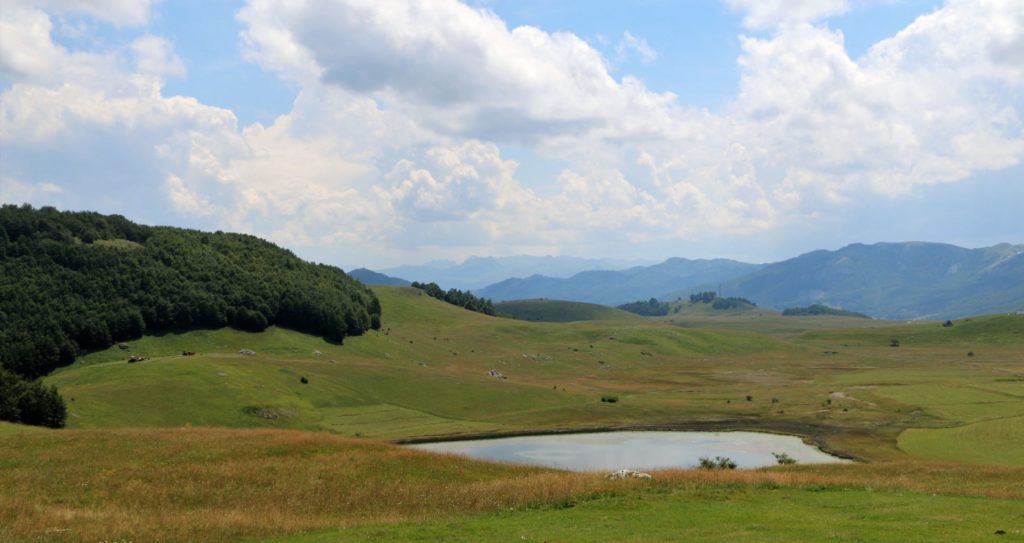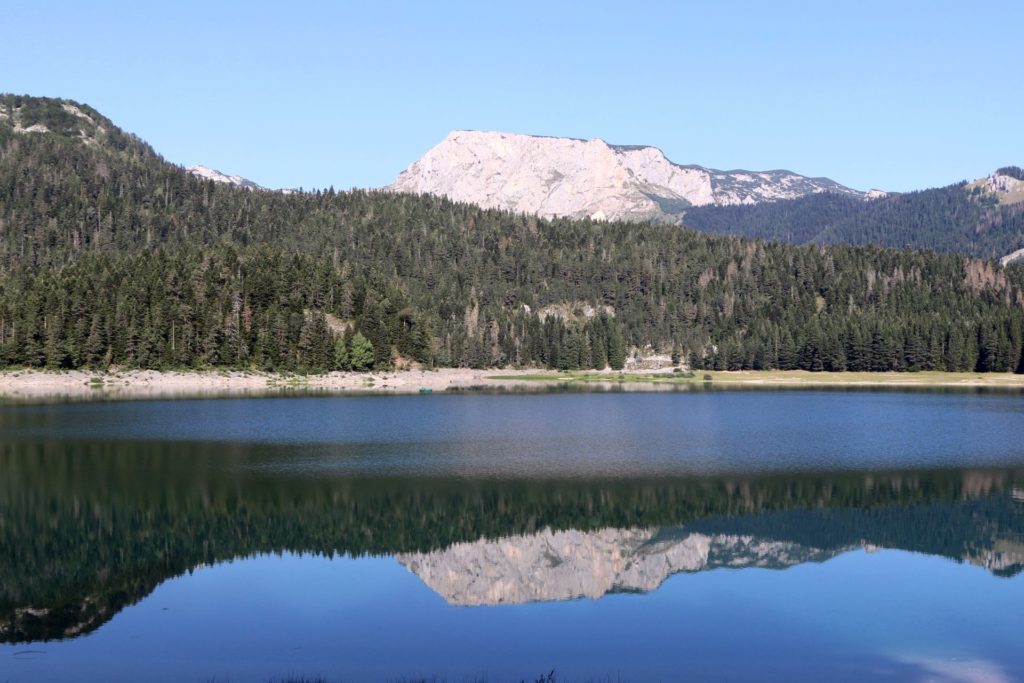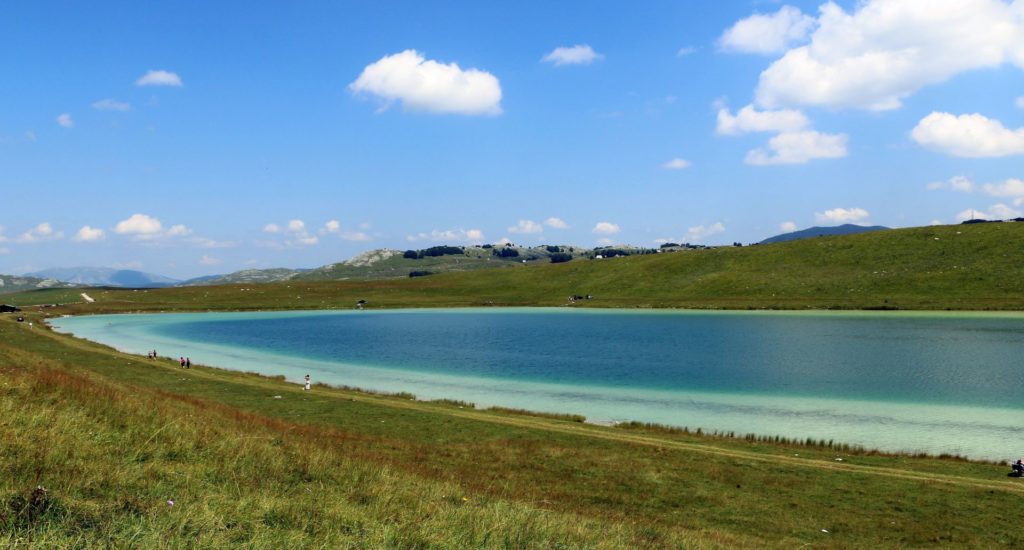This summer we have spent a wonderful time in the area of Durmitor National Park. And we were not the only ones. In mid-August, thousands of tourists were spending their summer holidays in Žabljak and surroundings. Many of them just came to escape from the heat and dust of the city and enjoy the cool mountain air and the traditional cuisine, but there were also a lot of tourists and adventurers eager to climb some of the surrounding mountain peaks: Bobotov Kuk (2,522 m), Crvena Greda, Prutaš, …
 But we had other plans; we knew that there are eighteen pristine glacial lakes nicknamed ‘mountain eyes’ (in translation: ‘gorske oči‘) in the Durmitor massif and – instead of making strenuous hiking tours to summits above 2,000 m – we decided to explore some of these lakes.
But we had other plans; we knew that there are eighteen pristine glacial lakes nicknamed ‘mountain eyes’ (in translation: ‘gorske oči‘) in the Durmitor massif and – instead of making strenuous hiking tours to summits above 2,000 m – we decided to explore some of these lakes.
Why are the Durmitor lakes called ‘mountain eyes’? In 1899, the Serbian geographer Jovan Cvijić started a scientific research of these lakes: he pointed at the fact that there is no other mountain range with such a large number of glacial lakes – lakes of different origin, size, colour, amount of water and beauty of the surrounding landscape. That’s why he called them ‘gorske oči´.
One day we made an easy hiking tour to three of the most famous Durmitor lakes: Crno Jezero, Zminje Jezero and Barno Jezero. A nice walk through pine forests, without significant elevation differences.
This spectacular lake (in translation: Black Lake) is the largest and most visited Durmitor lake. A hike around Crno jezero along the 3.6 km long walking path is a must for each visitor! Its position is wonderful: the rounded mass of Mount Međed (the ‘Bear’; 2287 m high), as its guardian behind it, casts an inky shadow over the pine-walled waters. Crno Jezero consists of two parts which are separated by a narrow land strip. Its altitude is 1,418 m above sea level. The lake is very deep – even up to 50 m – and is supplied by underground waters. During the day, the waters are not always black – they can take a variety of different colours – from light blue to dark green.
Following a picturesque trail along Mlinski Potok (Mill Creek), we continued our hike to
This lake (in translation: ‘Snakes Lake’) is hidden deep in the spruce forests at an altitude of 1,520 m. It is a calm and peaceful place, perfect for a picnic. We found some nice benches next to the water and, nearby, a water spring with cold, drinkable water.
It is interesting to know why the lake is called ‘Snakes Lake’. According to the legend, the Durmitor region was full of snakes in the past. But once, when winter arrived early, the snakes escaped to the area of Zminje Jezero, as they hoped to find a warmer place there. Unfortunately, the winter was too cold and snowy, so the snakes froze to death. When the winter was finally over, melting snow created a lake and the forests around were mirrored in the water looking like a snake’s skin.
Further down the trail, we reached Barno Jezero (in translation: ‘Swampy Lake’), a shallow lake in a swampy area, overgrown with dense vegetation and surrounded by pine forests. Around the lake we found many rare plants and mushrooms.
A car trip from Njegovuđa across the Jezerska Površ plateau – once the old caravan route from Nikšić to Pljevlja – offered several interesting sights. Opposite to Riblje Jezero (Fish Lake) – the name was given by the abundance of fish – is a necropolis with medieval tombstones (‘stećci’). And further down the road is
This intense blue-green lake (in translation: Devil’s Lake) is situated at an altitude of 1,411 m. It is 10.6 m deep. Although there were several families enjoying their picnic on the banks of the lake, the atmosphere was serene and peaceful.
But why is it called Devil’s Lake? There is a beautiful legend about that. A long time ago, the area around the lake was covered by pine forests. One day, a thunderstorm caused a forest fire and all the beasts living in the forest had to escape to the mountains. Only the devil and his wife fled to the bottom of the lake, where they built a wonderful castle, full of ice crystals. Even though Vražje Jezero is warmer than the other glacial lakes in the area, the coldness of the ice castle can still be felt in the middle of the lake. And take care: the devil has no peace! When he would see a young girl swimming in the lake, he might rise from his castle, grab her and drag her to the bottom….
 Along the road from Žabljak to Trsa we passed the village of Pošćenje and
Along the road from Žabljak to Trsa we passed the village of Pošćenje and
Pošćensko Jezero
This glacial lake is situated at an altitude of 1,487 m. The pastures separated by dry stone walls and the forests in the surroundings offer a magnificent panorama.
Before reaching the Sedlo Pass, we parked the car along the road and made an amazing hiking tour to Valovito Jezero and Modro Jezero. Passing a natural spring, we took the path downhill and soon arrived at the banks of
Situated at an altitude of 1.695 m, this lake has got its name by the Montenegrin word ‘val’ or ‘vao’, which means an area with a lot of fallen rocks. Indeed, big stones are surrounding the lake from all sides. The view of Valovito Jezero from the Sedlo Pass is spectacular! We walked along the steep shores, climbing the rocks and enjoying the wild landscape
Modro Jezero
This dark blue lake (modro = dark blue) is situated at an altitude of 1,609 m, at the foot of Sedlena Greda. I still remember the times when the lake was really dark blue and full of fish and frogs, when wild ducks drifted across the surface… But unfortunately, times have changed. Nowadays, this lake is being used for a new water supply system that will bring water to Žabljak. I know, these interventions are necessary, but what a pity… Not far away from this lake is Srablje Jezero, the smallest of all Durmitor lakes. At the time of our hike, this lake was dried up.
This lake in the Sušica Canyon is one of the periodical Durmitor Lakes. When we passed by in August, the lake had completely disappeared, but I still remember how it looked like in June: beautiful, picturesque, like a postcard. Spring is the time when the Sušica River fills the lake with water from melting snow, but this doesn’t last long and the lake dries up in July.
The last hike during our stay was one of the most beautiful tours. From Bosača we walked to
Jablan Jezero
At the very foot of Mount Crvena Greda, but at an altitude of 1,791 m, is Jablan Jezero (Poplar’s Lake) or Malo Jezero (Small Lake) as the locals sometimes call it. It is hard to understand why it is called ‘small lake’, as it is larger and deeper than many other Durmitor lakes – 8.5 m. We loved the walk through the forests and pastures, decorated with thousands of flowers and wild plants. The trail took us to one of the most beautiful ‘mountain eyes’, surrounded by the high cliffs of Crvena Greda.
These are only some of the ‘mountain eyes’ of Durmitor National Park – the most accessible ones. Each lake is unique, no matter if it is dominated by rocky cliffs and high peaks or situated in the middle of forests and pastures. And each of them shows the wild beauty of Montenegro’s nature…






